“Music theory is the study of the practices and possibilities of music.” Like most theories, it is extremely complex. But few studies revolve around the guitar as the main instrument. We will try to go through the basics of music theory with the guitar as a center of our attention.
Basic Terms
You might have heard terms like pitch and frequency before. Frequency is the number of vibrations or repeating in a unit of time. When we talk about music we measure a number of vibrations per second and the unit is Hertz. Pitch is a relative highness or lowness of a note. There are two main ways to write music as a guitar player.
Musical Notation

Music notation is the same as for any other instrument and guitar tablatures or tabs. So let’s dive into the first one, shall we?
In a picture below we can see a sample of music notation written for a C major scale. We will talk more about scales in detail later.
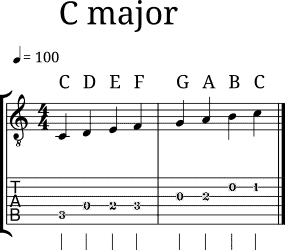
We can see five lines with four spaces between them. They are called Staff and they represent a pitch or the note that is written. Notes can go below or over those lines as we see with the first “C” note. The first symbol we see is a G clef or a treble clef. It is used to define the pitch range.
There are also C clef or alto and tenor clef and an F clef or a bass clef. The guitar music is written in G clef so we won’t talk about others. There are seven letters that we use for note names: A-B-C-D-E-F-G. As we can see from the picture, the lines represent notes E-G-B-D-F and the spaces between F-A-C-E.
Now, let’s check an example of few bars written in G clef

The next thing after the clef symbol is a time signature. In the example, it is 4/4 which is a pretty common time signature. There are other signatures like 3/4, 7/8, 6/4, etc. We can also see that there are lines dividing staff. That is a bar and each bar will have a total length of 4/4 in this example. We can see that there is a different number of notes in each bar. That is because they are of different lengths.
The symbol for the whole note is in the “C major” example, a half note is similar to a full note but with the vertical line.
The first and third bar is the same. The first bar consists of two 2/4 notes or two half notes. The dot beside the first note in the second bar represents a dotted note which means that it lengthens the note’s duration by one half.
We have a quarter and a half, eighth note, and two-quarter notes in the second bar which gives 4/4 in total. The fourth bar is the same as the second one. Using the “C major” chart we can see that the first two notes are A and B and we can do the same for the rest of the bars.
But what does all this mean to someone who is playing the guitar? There are five major notation lengths:
- The Full note which has an empty “circle” as a symbol. It is used for the example of the C major scale. The length of this note is one bar. So if the time signature is 4/4, we will have one note that lasts for the entire bar or 4 beats.
- The half note is used in the first and third bar in the example. It is marked with an empty circle and a stem. Length of the half note would be, in 4/4 time signature, two beats or half of the bar.
- The quarter note can be seen in the second and fourth bars. The third and fourth notes are quarters. They have a full circle and a stem-like a half note. In the 4/4 they will last for one beat or a quarter of a bar.
- The eighth note is similar to quarter, except it has a “flag” or a “hook”. It lasts for half of a beat or one-eighth of a bar.
- Sixteenth note. It has two flags and a full circle as a symbol. It is important to mention that there are lower lengths like thirty-second notes or sixty-four but they are not as common as the ones mentioned.
Guitar Tabs
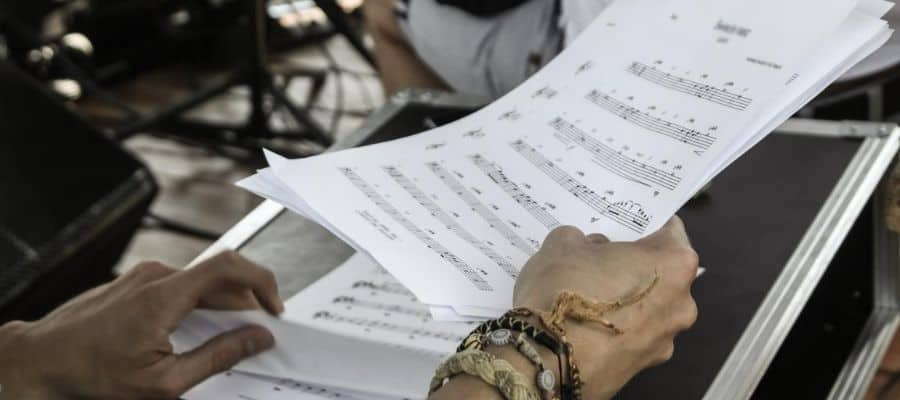
The second way of writing music is guitar tablatures or guitar tabs which is more popular for people who aren’t familiar with the first system.
Tablatures are a simpler way to write music because it’s more visual than the usual music notation.
There will be six lines representing each string and the numbers will show which fret we need to press in order to play a certain song. We will use standard guitar tuning for all exercises. Standard guitar tuning means that when we play each string we will get notes E A D G B E.
For example, the previous example consists of a tablature representation at the bottom as well.

The main difference between tabs and standard notation is that you have to know the song in order to play it from tabs. Guitar tabs will help you to learn the song you want to play.
But if you don’t know the song it will be nearly impossible for someone to play it because we can’t know the length of each note individually. The reason for this is that the tempo of the song or beats per minute (bpm) is rarely mentioned in the tabs and the length of each note.
Let’s explain this example. To play the first bar you need to pick the 3rd string on the 2nd fret and then an open 2nd string. To play the second bar you need to pick the 3rd string with the 2nd fret, then pick the 3rd string while it is open, then pick the 4th string with the 3rd fret and then an open 3rd string.
As you can see in this example below each tab you can see the length of the note, so you will be able to play it correctly.
The Notes Of The Guitar

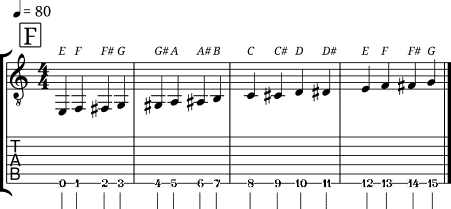
There are seven tones and five semitones. Guitar with 24 frets has 49 notes or 4 octaves. An octave composed of twelve semitones. It is the interval between the same two notes one played higher than the other. For example, refer back to the C major scale and notice that it start with the C and ends with a C, this is an octave.
the difference between two notes or one step is two frets. We can lower or raise any note by a semitone or a half step. When we move for one fret up or down the neck. For example, C note lowered by one semitone will become C flat or Cb and raised by a semitone will become C sharp or C#.
The heaviest string is the E string if played opened it represents the E note. The next note on a first fret will be F. It is important to know that there is no semitone between E and F and between B and C. Also, E# and F, Fb and E are the same note.
This is because when we write a scale we need to use different letters. It would be wrong to write C major scale as C D E E# G A B C instead of C D E F G A B C even though it is the same note.
Notes on the E strings are E F F# G G# A A# B C C# D D# and E again on 12th fret which is a full octave. The A string is the second string from the top and it is the same note as the fifth fret on an E string which is how a guitar is tuned.
Scales
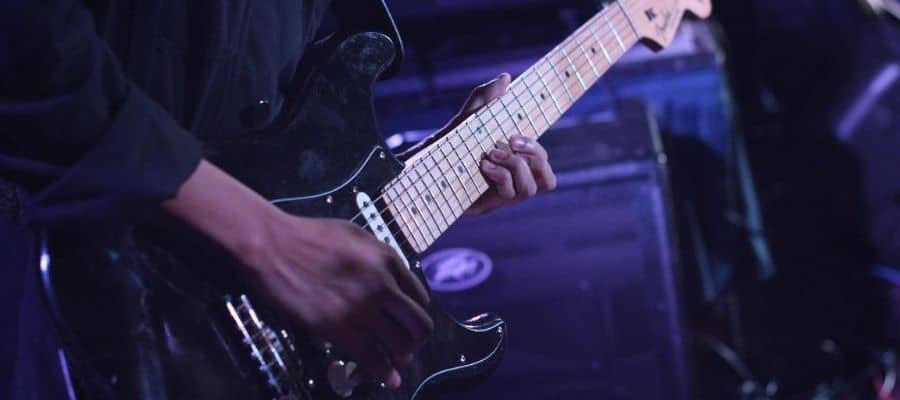
Scales are a collection of notes that are arranged in an ascending or descending order. When you hear a guitar player improvise an amazing guitar solo, he is using scales. We already mentioned the major scale because it is used to create other scales or other principles that we will go through later.
Major Scales

C major scale consists of the following notes: C D E F G A B C
Now that we know more about tones and semitones we can see that the formula for creating a major scale is the following:
C (whole tone) D (whole tone) E (semitone) F (whole tone) G (whole tone) A (whole tone) B (semitone) C
So the formula for creating any major scale would be: whole tone – whole tone – semitone – whole tone – whole tone -whole tone – semitone
So if we want to use an A major scale, the first tone would be A and following the formula, we will get: A B C# D E F# G# A

The reason we always mention C major at the beginning is that C major scale is the only one without flat or sharp notes. There are 12 major scales you can create using this formula.
Minor Scales
The minor scale is the second most popular scale in music. Every major scale has it’s the natural minor scale. For example C major and A minor are in a relative relationship.
If we take the formula used for creating a major scale and we apply it, but instead of starting from a first note we will start from sixth.
C major: C D E F G A B C
A minor: A B C D E F G A
We see that the formula for creating minor scale is the same as the one for major with the difference that it is “shifted”
A (whole) B (semitone) C (whole) D (whole) E (semitone) F (whole) G (whole) A.
Because C major is a relative major, A minor scale is the only scale without flats or sharps.
Using the formula we can create any minor scale. For example, C minor would be: C D D# F G G# A# C
This is the way most of the guitar players would write the scale because they rarely use flats. The correct way would be: C D Eb F G Ab Bb C

Pentatonic Scales
There are several types of pentatonic scales and they are one of the most popular in modern rock music. It is often created by removing IV and VII degree of the major scale. There are both minor and major pentatonic scales.

C major: C D E F G A B C
C major pentatonic: C D E G A C
For minor pentatonic we will remove II and VI degrees of the minor scale:
A minor: A B C D E F G A
A minor pentatonic: A C D E G A

But the most common version of this scale used the one that starts on the 5ft fret on the 6th string.
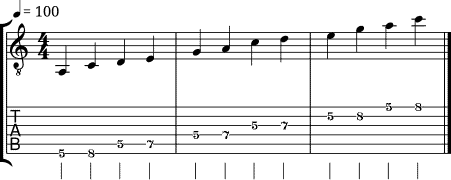
Harmonic Minor Scales
If we raise the VII degree of a natural minor scale we will get a harmonic minor scale
A minor: A B C D E F G A
Harmonic A minor: A B C D E F G# A

Melodic Minor Scales
Raising the VI and VII degree of the minor scale while ascending and lowering them while descending will give us melodic minor scale
A minor: A B C D E F G A
Melodic A minor: A B C D E F# G# A

Chromatic Scale
While the chromatic scale is used rarely in playing it is important for music theory. The chromatic scale consists of all twelve tones in an octave and it would go like this:
C C# D D# E F F# G G# A A# B C


Chords
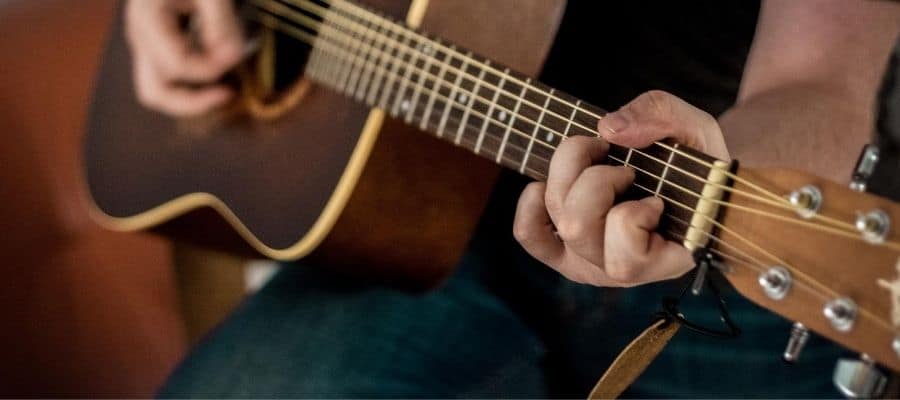
If we play three or more notes at the same time we will get a chord. There are many types of chords and the most used or basic ones are major and minor chords.
Major Chords
If we take the first, third and fifth notes from the major scale we will get a chord. For C major chord those notes would be C, E and G, and the chord would be C major.
When you are checking chords for a song you will notice that C major is usually written only as “C” or C major. Those three notes from a major scale are also called a major triad. You can do that for any major scale, just follow the formula and you will get a major triad.
C major scale: C D E F G A B C.
Formula: 1 3 5.
Notes for C Major: C E G.
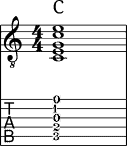
Minor Chords
For minors, we will use different formulas but a major scale. For example, if we need D minor chord we will take the first, flat third and the fifth note from the D major scale and we will get a D minor chord:
1st note is D, the flat third would be flat F# which means it goes to F natural and the fifth is A. Minor chords are usually noted with a small letter m next to a note name (Cm, C#m, Dm, or G min, A min, etc)
D major scale: D E F# G A B C# D.
Formula: 1 b3 5.
Notes for D Major: D F G.
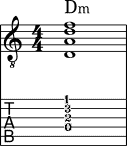
Diminished Chords
Diminished chords will use the major scale but take the first, flat third and flat fifth. It is usually written as A dim
A major scale: A B C# D E F# G# A.
Formula: 1 b3 b5.
Notes for A dim: A C (Eb or D#).
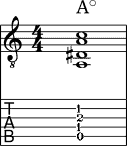
Augmented Chords
Augmented chords will also use a major scale. They are built using the first, third and a sharp fifth
G major scale: G A B C D E F# G.
Formula: 1 3 5#.
Notes for G aug: G B D#.
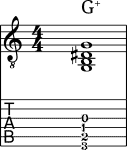
Suspended Chords
Suspended chords or Sus chords are built with the first, second and fifth or the first, fourth and fifth. Using these two formulae we can get Sus2 and Sus4 chords. For example on the E major scale:
E major: E F# G# A B C# D# E.
Formula: 1 2 5 or 1 4 5.
We will get E F# and B for Esus2 or E A B for Esus4.
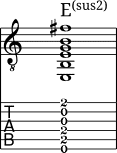
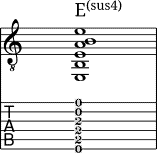
It is important to mention that there are other chords and other types like 7th chords or 9th, along with diminished combinations of all of them. They all use a similar formula for building and are based on a major scale.
While playing guitar we can add several notes to get a richer sound. For example, on an open C major chord, we will have two C, two E, and one G note. All the chords that are played in popular music are based on the formula we mentioned and often use those three notes in a different octave to get the fuller and more rich sound.
Barre Chords
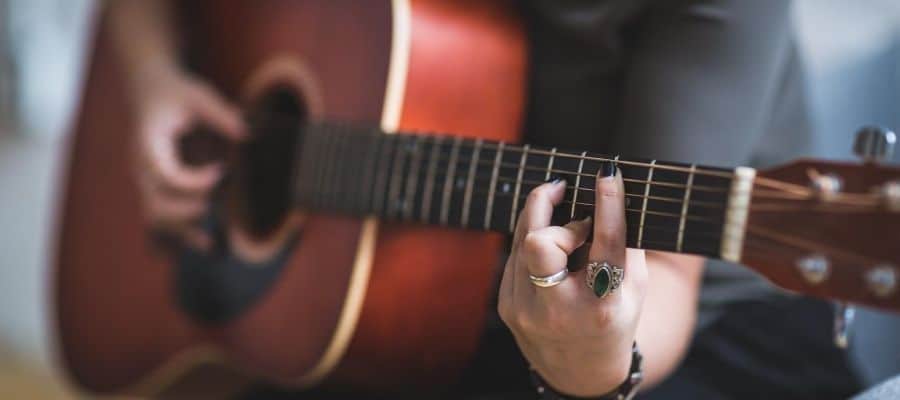
What is unique for playing guitar are chords or finger shapes. If take A major barre chord the tab for the chord would look like this:
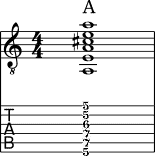
Now, if we take that finger shape to be any major chord with a different root note, we can use it for any other major chord. And the same rule applies for any other chords type
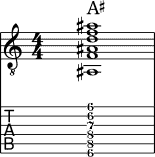
Just moving the whole shape for one fret we will go from A major to A# major. Many players tend to learn only where the root note is and then remember shapes. That way they don’t have to think about the rest of the notes, just use the shape on the root note and they will get the desired chord.
If you wish to expand your knowledge about guitar theory on guitar chords, you can check out my posts
Rhythm

Rhythm is defined as any regular recurring motion, symmetry. We already mentioned that there are different time signatures and the most common is 4/4 (four-four) also known as “C”.
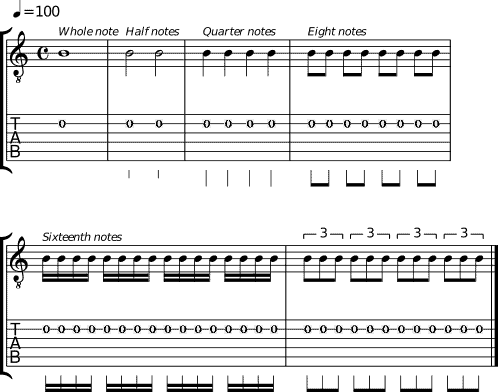
We can see that the whole note receives 4 beats in four-four time value.
- Whole note receives four beats
- Half note receives two beats.
- A quarter note receives one beat.
- An eighth note receives half of a beat.
- A sixteenth note receives one-quarter of a beat
- the triplet will receive one-third of a beat.
Sometimes in music, there is no note played for a whole bar or for half of the bar. When that happens we still need to notate that pause or rest. You can see the symbols for rests depending on their length.

One of the best ways for a player to feel the rhythm and be sure to not be late or early is to use his foot. You might have seen guitar players tapping their foot on the ground while playing. It is a great way to understand the rhythm better.
For example in four-four or any other simple time signatures, you would tap on each beat. On a more complex time like 12/8, you would want to tap on each major division.
For playing rhythm guitar, you can find the chord book or a chart where you would be able to see the chords that are played in a certain song. With the combination of upstrokes and downstrokes, we can get different rhythms using different time values for chords.
Circle of Fifths
Circle of fifths is a term used to describe the relationship between 12 notes of the chromatic scale, key signatures and major and minor keys.
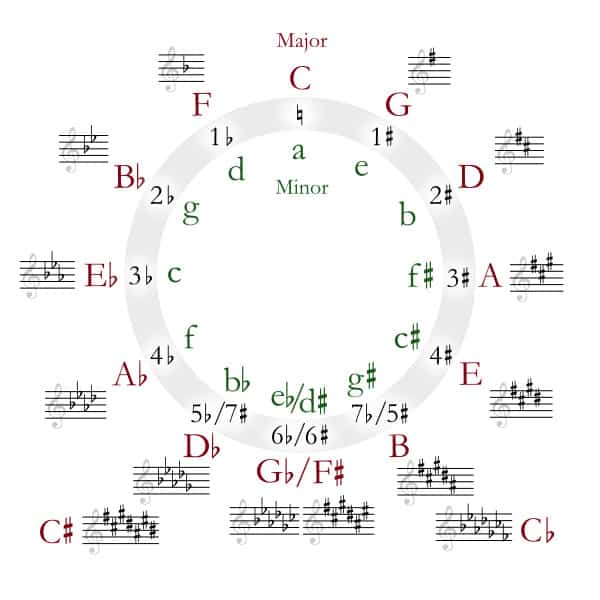
We can see major notes marked red and minor marked green. The circle of fifths is used to determine the five chords that can be used depending on the key to creating new music.
The term is first mentioned in the 17th century and it’s been around ever since. It is quite a helpful tool to determine a chord progression while creating new music. The formula used can get us a common chord progression for basic keys using both major and minor chords.
The formula for common chord progression is I ii iii IV V vi. The letters in uppercase are for major and the lower case for the minor. The chord progression is major, minor. minor, major, major, minor
Where number I is the root or the key we want our song to be in. Upper case letters are used for the major and lower case for minor chords. The vi chord is a natural minor of the root of the key. The IV and V are found moving counterclockwise and clockwise from the root chord and ii and iii are the natural minors of IV and V.
So for example on an E major: E will be our I; IV and V are found counter-clockwise which is A and clockwise which is B; their respective natural minors are f# and g#; vii is the natural minor of E which is C#
When we use it in a formula we will get: E F#m G#m A B C#m
This is the reason chord progressions like D-G-C are so common and so popular. You have countless songs using the same chord progression because it’s easy and always sounds good.
Modes
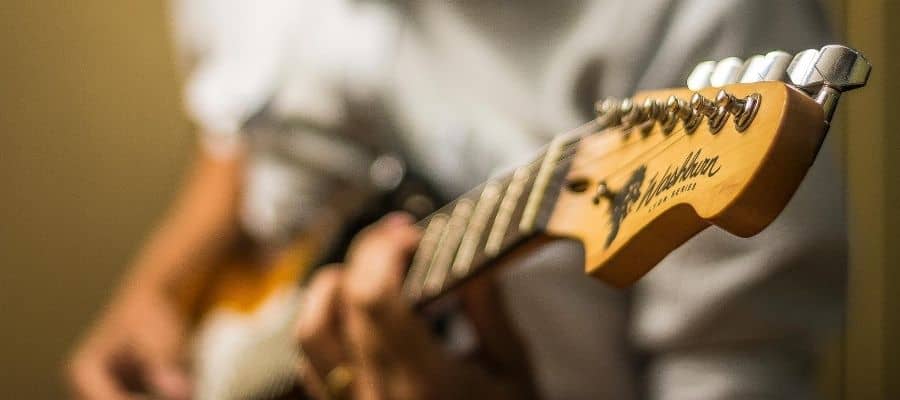
Now to spice things up a bit, let’s talk about modes. A mode is a type of scale that gives a different character or tone compared to a related major or minor scale.
There are seven types of modes in modern music. They are derived from the major scale using the same method we mentioned earlier. The only difference is the start note and the correlation between the modes.
Ionian
The first mode is called Ionian and it is the major scale we mentioned before. This time we will talk start with F major scale because it is the first fret of the heaviest string on the guitar. Ionian mode is built (as we talked before) W-W-S-W-W-W-S where (W) is a whole note and (S) is a semitone. In F major it would be F-G-A-Bb-C-D-E
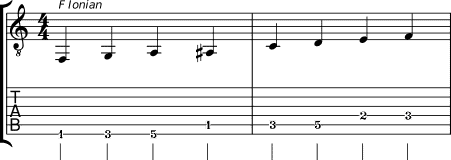
Dorian
The second mode is called Dorian and we will use the previous formula and move it for one note. So F major or Ionian will have a relative G Dorian scale. The formula will be W-S-W-W-W-S-W and the notes will be G-A-Bb-C-D-E-F. Now F will be the last note instead of the first.

Phrygian
Using the same “cycling” method. The next relative scale, Phrygian, will be A Phrygian and the formula is S-W-W-W-S-W-W. Notes for A Phrygian are: A-Bb-C-D-E-F-G

Lydian
The fourth mode is the Lydian mode. The formula is W-W-W-S-W-W-S and the relative for F major is Bb Lydian; notes are Bb-C-D-E-F-G-A

Mixolydian
Mixolydian scale, related to F major is C. Formula is W-W-S-W-W-S-W with notes C-D-E-F-G-A-Bb

Aeolian
We already talked about the Aeolian scale before. Aeolian is actually a natural minor scale. And D minor is natural to F major. Using W-S-W-W-S-W-W we get D Aeolian scale D-E-F-G-A-Bb-C

Locrian
Locrian is the last mode and the formula is S-W-W-S-W-W-W and for F major would be E Locrian and notes would be E-F-G-A-Bb-C-D
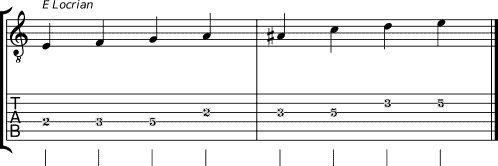
Using the formula we mentioned you can create any scale you want. One of the reasons I wrote about F major and its modes is because it is a great way to learn the fretboard of the guitar.
Out of the seven modes we mentioned; Ionian, Lydian, and Mixolydian are major modes; Aeolian, Dorian, and Phrygian are minor modes; Locrian is the diminished mode. The scales and modes work the same way as chords. If you are learning about shapes, you can always remember the shape of the scale and if you shift all notes for one fret you will get that scale in a different key without changing the shape of the scale.
Conclusion
While we only scratched the surface of music theory, there are countless of other chords, keys, and scales that might help you become the best guitar player in the world. But these basic tips and lessons might get you started.
If you found this article useful, you may want to save this pin below to your Guitar board.

8 thoughts on “Guitar Music Theory In-Depth Basics”
Leave a Reply to kiran Cancel reply
Recent Posts
When learning new songs have you noticed that some of the chord sequences sound really good? But when you tried to come up with your own chord sequence, or as we call it chord progression, you found...
Some guitarists insist on buying an expensive amplifier with their electric guitar. They assume that this is a must for every type of guitarist out there. However, in some situations, this isn’t...


You have really helped me under stand some things I’m lost what is the meaning of the b in front of 3-6-7 in a scale and w.w and s. What is the s
Hi Ike,
Glad I helped you 🙂
The b stands for “bemol” or as others know it “flat”, and it means that you need to go back one semitone on the note.
As for the W and S. W = whole note, S = Semitone (half note).
you did not mention about sevenths, thirtheenth’s and ninth’s chords.
Yes, I didn’t.
Because I wanted to keep it basic. simple, as much as I can.
later on, I will do a more advanced topics
Hi ,
The content was superb. i have recollected all my lessons learnt 8 years back.
you have put it in a clear way. Thank you so much.
But just curious to know you did not mention about sevenths, thirteenth’s and ninth’s chords.
Thank you! Glad it was clear.
I kept the 7th and the 9th out of this article because I wanted to keep it simple as much as I can.
This topic can become difficult really fast and you can lose your self.
This is indeed a good job, thanks a lot
But the application of the circle of fifth is the only one I need to understand better
Hi Sunday,
No problem! glad it helped you. .
I will try to see if I can write something more detailed about the circle of fifths.